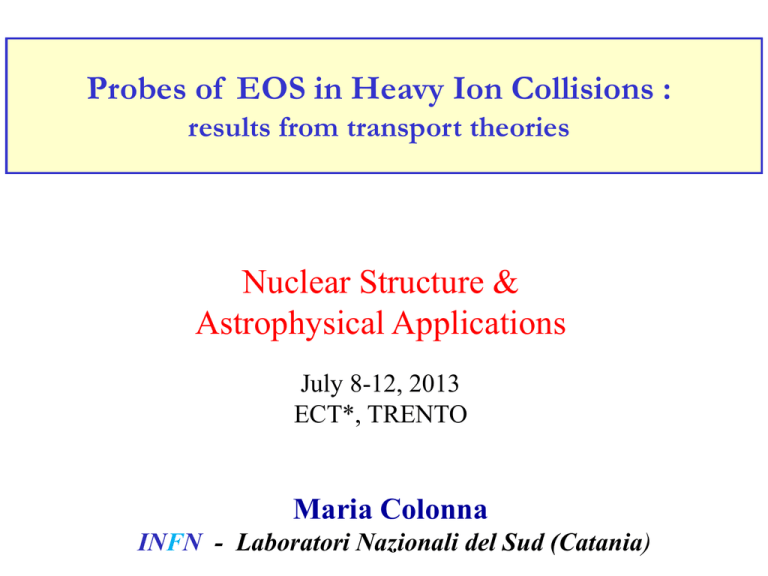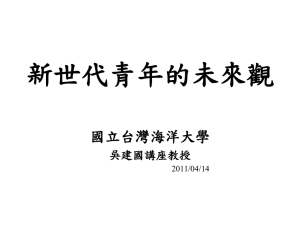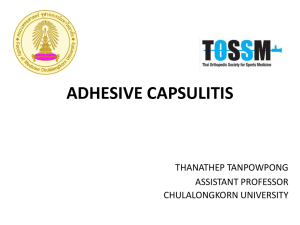Probes of EOS in Heavy Ion Collisions : results from transport
advertisement

Probes of EOS in Heavy Ion Collisions : results from transport theories Nuclear Structure & Astrophysical Applications July 8-12, 2013 ECT*, TRENTO Maria Colonna INFN - Laboratori Nazionali del Sud (Catania) Heavy Ion Collisions: a way to create Nuclear Matter in several conditions of ρ, T, N/Z… Nuclear effective interaction Equation of State (EOS) Self-consistent Mean Field calculations (like HF) are a powerful framework to understand the structure of mediumheavy (exotic) nuclei. Source: F.Gulminelli Widely employed in the astrophysical context (modelization of neutron stars and supernova explosion) Dynamics of many-body systems i ρ1 (1,1' , t) 2 12 | [H, ρ 2 (t)] | 1'2 t i ρ 2 (12,1'2' , t) 12 | [H, ρ 2 (t)] | 1'2' O( 3 ) t ρ2 (12,1'2') ρ1 (1,1')ρ1 (2,2') (12,1'2') one-body H H0 v1,2 Mean-field Residual interaction i ρ1 (1,1' , t) 1 | [H 0 , ρ1 (t)] | 1' K[ρ1 ] δK[ρ 1 , ] t TDHF K F ( 1 , | v |2 ) K F (v, ) Average effect of the residual interaction K 0 KK Fluctuations Dynamics of many-body systems K f 1 f Transition rate W Interpreted in terms of NN cross section -- If statistical fluctuations larger than quantum ones K ( p, t )K ( p' , t ' ) C (t t ' ) Main ingredients: Residual interaction (2-body correlations and fluctuations) In-medium nucleon cross section Effective interaction (self consistent mean-field) see BHF 1. Semi-classical approximation Transport equation for the one-body distribution function f Chomaz,Colonna, Randrup Phys. Rep. 389 (2004) Baran,Colonna,Greco, Di Toro Phys. Rep. 410, 335 (2005) (semi-classical analog of Wigner function) df r , p, t f r , p, t f , h Ik I coll coll f δk dt t Vlasov Residual interaction: Correlations, Fluctuations Boltzmann-Langevin (BL) equation Two-body Collision Integral f 1 f vrel 3 (1,2) 2 (3,4) 1 Fluctuations in collision integral 4 Stochastic Mean-Field (SMF) model Fluctuations are projected in coordinate space (density profile) 2. Molecular Dynamics approaches (AMD, ImQMD, QMD,…) A.Ono, Phys.Rev.C59,853(1999) Zhang and Li, PRC74,014602(2006) J.Aichelin, Phys.Rep.202,233(1991) stochastic NN collisions Collision integral fully stochastic, but approx. description of mean-field effects… Colonna, Ono, Rizzo, Phys. Rev..C82,054613 (2010) Effective interactions and symmetry energy The nuclear interaction, contained in the Hamiltonian H, is represented by effective interactions (Skyrme, Gogny, …) E/A (ρ) = Es(ρ) + Esym(ρ) β² The density dependence of Esym is rather controversial, since there exist effective interactions leading to a variety of shapes for Esym: Esym ( / 0 )g g1 Asysoft, around ρ0 g1 Asystiff 0 Esym ( ) S0 L ... 3 0 γ = L/(3S0) Investigate the sensitivity of the reaction dynamics to this ingredient Put some constraints on the effective interactions EOS β=(ρn-ρp)/ρ Symmetry energy Neutron skin Isovector modes Pigmy resonances Asysoft γ = 0.5 γ=1 Asystiff Low-energy reaction mechanisms: Fusion, Deep-Inelastic, Charge equilibration Fragmentation mechanisms at Fermi energies Study of the PDR with transport theories Low energy reaction mechanisms Fusion vs Deep Inelastic Competition between reaction mechanisms: fusion vs deep-inelastic 36Ar + 96Zr , E/A = 9 MeV Fusion or break-up ? Fusion probabilities may depend on the N/Z of the reaction partners: - A mechanism to test the isovector part of the nuclear interaction Important role of fluctuations C.Rizzo et al., PRC83, 014604 (2011) Competition between reaction mechanisms t=0 t = 40 t = 100 t = 140 t = 200 fm/c θ 36Ar + 96Zr , E/A = 9 MeV, b = 6 fm β2 , β3, E*~250 MeV, J ~70ћ z (fm) Starting from t = 200-300 fm/c, solve the Langevin Equation (LE) for selected degrees of freedom: Q (quadrupole), β3 (octupole), θ, and related velocities Examples of trajectories Break-up times of the order of 500-1000 fm/c ! Extract the fusion cross section soft stiff Break-up configurations Shvedov, Colonna, Di Toro, PRC 81, 054605 (2010) l (ћ) Charge equilibration in fusion and D.I. collisions A1 A2 TDHF calculations Initial Dipole D(t) : bremss. dipole radiation CN: stat. GDR If N1/Z1 ≠ N2/Z2 Relative motion of neutron and proton centers of mass NZ 1 X p (t ) X n (t ) X p ,n xip ,n A Z, N 1 DK (t ) Pp Pn Pp ,nSMF simulations pip ,n Z, N D, DK i D(t ) Simenel et al, PRC 76, 024609 (2007) 132Sn + 58Ni , D0 = 45 fm E/A = 10 MeV 40Ca C.Rizzo et al., PRC 83, 014604 (2011) + 100Mo Dynamical dipole emission B.Martin et al., PLB 664 (2008) 47 Bremsstrahlung: Quantitative estimation 36Ar 2 2 dP 2e NZ '' D ( ) 3 dEg 3c Eg A 2 + 96Zr 40Ar + 92Zr V.Baran, D.M.Brink, M.Colonna, M.Di Toro, PRL.87 (2001) Experimental evidence of the extra-yield (LNS data) stiff soft Asysoft larger symmetry energy, larger effect (30 %) soft C.Rizzo et al., PRC83, 014604 (2011) see also A.Corsi et al., PLB 679, 197 (2009), LNL experiments stiff D.Pierroutsakou et al., PRC80, 024612 (2009) Charge equilibration in D.I. collisions at ~ 30 MeV/A low energy -- Charge equilibration: from dipole oscillations to diffusion Overdamped dipole oscillation -t/ d D(t) τd D(t) D(0)e Esym t 1(PLF) Full N/Z equilibration not reached: Degree of eq. ruled by contact time and symmetry energy 2(TLF) Observable: (N/Z)CP = N/Z of light charge particles emitted by PLF as a function of Ediss Ecm - Ekin (PLF T LF) Dissipated energy: (impact parameter, contact time) Ediss / Ecm INDRA data, Galichet et al., PRC (2010) “Isospin diffusion” in D.I. collisions Mass(A) ~ Mass(B) ; N/Z(A) = N/Z(B) (TLF) Isospin transport ratio R : B. Tsang et al., PRL 102 (2009) A dominance mixing 2 X AB X AA X BB R X AA X BB B dominance B +1 0 -1 (PLF) A -- AA and BB refer to two symmetric reactions between n-rich and n-poor nuclei AB to the mixed reaction -- X is an observable related to the N/Z of PLF (or TLF) X = N/ZPLF stiff X = Y(7Li)/ Y(7Be) soft More central collisions: larger contact time more dissipation, smaller R Good sensitivity to Asy-EoS Comparison between ImQMD calculations and MSU data SMF calculations, 124Sn +112Sn, 50 AMeV B. Tsang et al., PRL 102 (2009) J. Rizzo et al., NPA(2008) “Exotic” fragments in reactions at Fermi energies Fragmentation mechanisms at Fermi energies Y.Zhang et al., PRC(2011) PLF dynamical emission TLF IMF VREL / VVIOLA (1,3) 124Sn + 64Ni 35 AMeV: 4π CHIMERA detector Fragment emission at mid-rapidity Charge Z (neck emission) neutron-enrichment of the neck region E. De Filippo et al., PRC(2012) Isospin migration in neck fragmentation Transfer of asymmetry from PLF and TLF to the low density neck region: neutron enrichment of the neck region Asymmetry flux Effect related to the derivative of the symmetry energy with respect to density ρIMF < ρPLF(TLF) Density gradients derivative of Esym b = 6 fm, 50 AMeV stiff - full J.Rizzo et al. NPA806 (2008) 79 PLF, TLF neck emitted nucleons asy-soft asy-stiff Larger derivative with asy-stiff larger isospin migration effects Sn112 Sn124 + Sn112 + Sn124 The asymmetry of the neck is larger than the asymmetry of PLF (TLF) in the stiff case Comparison with Chimera data Properties of ‘dynamically emitted’ (DE) fragments Charge distribution Parallel velocity distribution Good reproduction of overall dynamics The N/Z content of IMF’s in better reproduced by asystiff (L =75 MeV) DE SE 124Sn + 64Ni 35 AMeV E. De Filippo et al., PRC(2012) “Exotic” collective excitations in Nuclei The Isovector Dipole Response (DR) in neutron-rich nuclei Isovector dipole response Pygmy dipole strength Giant DR GDR Pygmy DR PDR Klimkiewicz et al. X.Roca-Maza et al., PRC 85(2012) X neutrons – protons Xc core neutrons-protons Y excess neutrons - core Neutron center of mass Proton center of mass 132Sn • Pygmy-like initial conditions (Y) X Y Xc Neutron skin and core are coupled The low- energy response is not sensitive to the asy-stiffness 25.0 Baran et al. see M.Urban, PRC85, 034322 (2012) -- soft -- stiff -- superstiff • GDR-like initial conditions (X) Fourier transform of D Strength of the Dipole Response E (MeV) PDR is isoscalar-like GDR is isovector-like frequency not dependent on Esym dependent on Esym The strength in the PDR region depends on the asy-stiffness (increases with L) Larger L larger strength , but also Larger L larger neutron skin see A.Carbone et al., PRC 81 (2010) 2.7 % soft 4.4 % stiff 4.5 % superstiff PDR energy and strength (a systematic study) superstiff stiff soft The energy centroid of the PDR as a function of the mass for Sn isotopes, 48Ca, 68Ni, 86Kr, 208Pb ~ 41 A-1/3 Correlation between the EWSR exhausted by the PDR and the neutron skin extension V.Baran et al., arXiv:1306.4969 Neutron skin extension with soft, stiff and superstiff superstiff stiff soft “Summary” of Esym constraints Asysoft Asystiff Reduce experimental error bars Isospin diffusion Galichet 2010 De Filippo 2012 Perform more complete analyses Improve theoretical description (overcome problems related to model dependence) A.Carbone et al., PRC 81 (2010) V.Baran (NIPNE HH,Bucharest) M.Di Toro, C.Rizzo, J.Rizzo, (LNS, Catania) M.Zielinska-Pfabe (Smith College) H.H.Wolter (Munich) E.Galichet, P.Napolitani (IPN, Orsay) Heavy Ion Collisions (HIC) allow one to explore the behavior of nuclear matter under several conditions of density, temperature, spin, isospin, … HIC from low to Fermi energies (~10-60 MeV/A) are a way to probe the density domain just around and below normal density. The reaction dynamics is largely affected by surface effects, at the borderline with nuclear structure. Increasing the beam energy, high density regions become accessible. Varying the N/Z of the colliding nuclei (up to exotic systems) , it becomes possible to test the isovector part of the nuclear interaction (symmetry energy) around and below normal density. “Summary” of Esym constraints M.B.Tsang et al., PRC (2012) A.Carbone et al., PRC 81 (2010) V.Baran (NIPNE HH,Bucharest) M.Di Toro, C.Rizzo, J.Rizzo, (LNS, Catania) M.Zielinska-Pfabe (Smith College) H.H.Wolter (Munich) E.Galichet, P.Napolitani (IPN, Orsay) PLF PLF CP CP SMF transport calculations: Data: N/Z of the PLF (Quasi-Projectile) open points higher than full points Squares: soft Stars: stiff (n-rich mid-rapidity particles) IsospinAfter equilibration statisticalreached decay : for Ediss/Ecm = 0.7-0.8 ? = Σfull i Nidots , Z =converge) Σi Zi (open N and N/ZCP Data fall between the two calculations Charged particles: Z=1-4 Comparison with data -- stiff (γ=1) + SIMON -- soft(γ=0.6) + SIMON forward PLF PLF PLF CP CP Calculations: - N/Z increases with the centrality of collision for the two systems and energies (For Ni + Ni pre-equilibrium effects) - In Ni + Au systems more isospin diffusion for asy-soft (as expected) - (N/Z)CP linearly correlated to (N/Z)QP forward n-n c.m. Interpretation in terms of isovector-like and isoscalar-like modes in asymmetric systems Energy-density variation p p p2 2 p n n p n n n2 Curvature matrix Normal modes stiff soft Isoscalar-like Isovector-like tan( ) p n α =450 for symmetric matter c c tan(2 ) a b 8I ( E L ) sym 3 0 Zero temperature α increases with L strength in the PDR region (isoscalar-like mode) increases with L nuclear matter in a box Fragment isotopic distribution and symmetry energy Fragmentation can be associated with mean-field instabilities (growth of unstable collective modes) Oscillations of the total (isoscalar-like density) and average Z/A (see δρn /δρp ) λ = 2π/k fragment formation stiff soft Oscillations of the isovector density (ρn - ρp ) and distributions (Y2 / Y1 , isoscaling) isotopic variance Study of isovector fluctuations, link with symmetry energy in fragmentation At equilibrium, according to the fluctuation-dissipation theorem Isovector density ρv = ρn –ρp Fv coincides with the free symmetry energy at the considered density What does really happen in fragmentation ? Nuclear matter in a box T Full SMF simulations freeze-out T = 3 MeV, Density: ρ1 = 0.025 fm-3 , 2ρ1 , 3ρ1 I = 0.14 ρ M.Colonna, PRL,110(2013) ρ F’ ~ T / σ Average Z/A and isovector fluctuations as a function of local density ρ soft stiff stiff soft F’ follows the local equilibrium value ! The isospin distillation effect goes together with the isovector variance high density low density I Dissipation and fragmentation in “MD” models ImQMD calculations, 112Sn +112Sn, 50 AMeV More ‘explosive’ dynamics: more fragments and light clusters emitted more ‘transparency’ Y.Zhang et al., PRC(2011) 124Sn y vz +112Sn, 50 AMeV Isospin transport ratio R What happens to charge equilibration ? Rather flat behavior with impact parameter b: - Weak dependence on b of reaction dynamics ? - Other dissipation sources (not nucleon exchange) ? fluctuations, cluster emission weak nucleon exchange Comparison SMF-ImQMD 6 fm 8 fm γ = 0.5 SMF = dashed lines ImQMD = full lines For semi-central impact parameters: Larger transparency in ImQMD (but not so a drastic effect) Other sources of dissipation (in addition to nucleon exchange) More cluster emission Isospin transport R around PLF rapidity: γ=2 SMF Good agreement in peripheral reactions ImQMD Elsewhere the different dynamics (nucleon exchange less important in ImQMD) leads to less iso-equilibration What about fragment N/Z ? Different trends in ImQMD and SMF! γ = 0.5 Details of SMF model • Correlations are introduced in the time evolution of the one-body density: ρ ρ +δρ as corrections of the mean-field trajectory • Correlated density domains appear due to the occurrence of mean-field (spinodal) instabilities at low density Fragmentation Mechanism: spinodal decomposition T gas Is it possible to reconstruct fragments and calculate their properties only from f ? liquid ρ Extract random A nucleons among test particle distribution Coalescence procedure Check energy and momentum conservation A.Bonasera et al, PLB244, 169 (1990) Liquid phase: ρ > 1/5 ρ0 Fragment Neighbouring cells are connected Recognition (coalescence procedure) Fragment excitation energy evaluated by subtracting Fermi motion (local density approx) from Kinetic energy Several aspects of multifragmentation in central and semi-peripheral collisions well reproduced by the model Chomaz,Colonna, Randrup Phys. Rep. 389 (2004) Statistical analysis of the fragmentation path Comparison with AMD results Baran,Colonna,Greco, Di Toro Phys. Rep. 410, 335 (2005) Tabacaru et al., NPA764, 371 (2006) A.H. Raduta, Colonna, Baran, Di Toro, ., PRC 74,034604(2006) PRC76, 024602 (2007) Rizzo, Colonna, Ono, PRC 76, 024611 (2007) i







